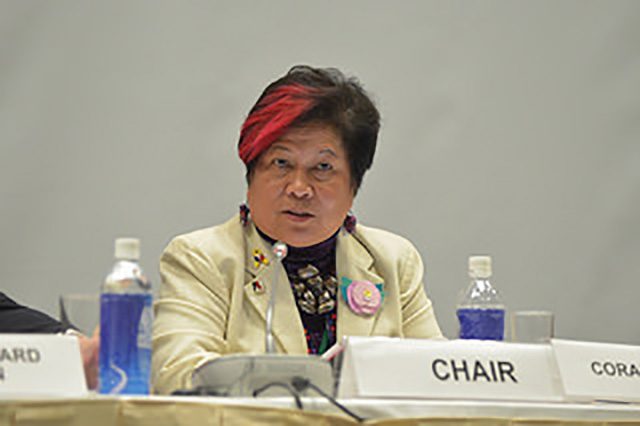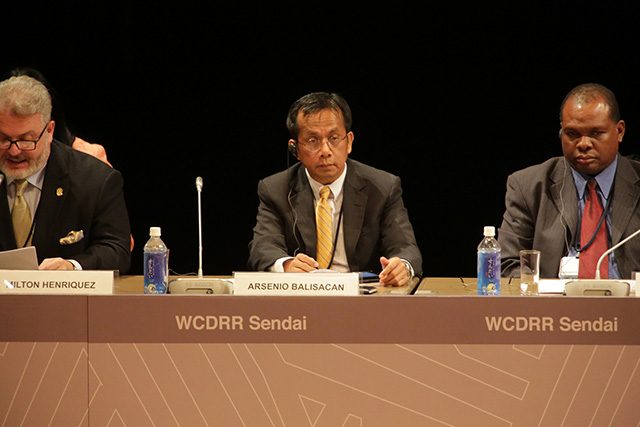SUMMARY
This is AI generated summarization, which may have errors. For context, always refer to the full article.

MANILA, Philippines – Wednesday, March 18, was supposedly the last day of the 3rd United Nations (UN) World Conference on Disaster Risk Reduction, but the conference went overtime until midnight of Thursday, March 19, to approve a post-2015 framework for disaster risk reduction.
The most contentious issue during the last 72 hours was countries’ commitment on resources, Social Welfare Secretary Corazon Soliman said in a news conference Friday, March 20.
“It really became a difficult negotiation. It was a negotiation where issues of indicators and targets were very contentious, and is really looking at what countries are willing to commit so that they will be able to ensure that there will be risks reduced,” she added.
Soliman headed the Philippine delegation to the conference, which included Senator Loren Legarda, Climate Change Commissioner Lucille Sering, Public Works Secretary Rogelio Singson, and Socioeconomic Planning Secretary Arsenio Balisacan, among others.
In this negotiation, Soliman said disaster-prone Philippines helped provide a richer discussion. (READ: PH to share ‘best practices’ for new int’l disaster framework)
“We have shown the world that we have learned our lesson,” Soliman said, referring to Super Typhoon Yolanda (Haiyan) – the strongest typhoon in recent history which ravaged the Visayas in 2013.
For instance, Singson talked about rebuilding infrastructure that is disaster-resilient, while Balisacan spoke of the Philippines’ economic loss in the aftermath of Yolanda.

Delegates from the Philippine Atmospheric, Geophysical, and Astronomical Services Administration also showed how the state weather bureau can now forecast better using the light ranging and detection (LiDAR) technology.
Soliman added that countries at the conference appreciated the Philippines for its strong government coordination, its various disaster risk reduction legal frameworks, and the pre-disaster risk assessment that it first implemented during Typhoon Ruby (Hagupit) in December 2014. (READ: Typhoon Ruby: Have we learned lessons from Yolanda?)
“There are many partnerships that we have been able to forge specifically with those interested in supporting renewable energies and building resilience by way of a risk-informed analysis and risk-informed decision,” she added.
The Philippines committed to the Sendai Framework for Disaster Risk Reduction 2015-2030, the successor of 10-year-old Hyogo Framework for Action (HFA).
In the 25-page framework, countries came up with 4 priority areas for action:
- Understanding disaster risk
- Strengthening disaster risk governance to manage disaster risk
- Investing in disaster risk reduction for resilience
- Enhancing disaster preparedness for effective response, and to “Build Back Better” in recovery, rehabilitation, and reconstruction
Countries also agreed on 7 global targets that will be measured at the global level:
- Substantially reduce global disaster mortality by 2030, aiming to lower average per 100,000 global mortality between 2020-2030 compared to 2005-2015.
- Substantially reduce the number of affected people globally by 2030, aiming to lower the average global figure per 100,000 between 2020-2030 compared to 2005-2015.
- Reduce direct disaster economic loss in relation to global gross domestic product (GDP) by 2030.
- Substantially reduce disaster damage to critical infrastructure and disruption of basic services, among them health and educational facilities, including through developing their resilience by 2030.
- Substantially increase the number of countries with national and local disaster risk reduction strategies by 2020.
- Substantially enhance international cooperation to developing countries through adequate and sustainable support to complement their national actions for implementation of this framework by 2030.
- Substantially increase the availability of and access to multi-hazard early warning systems and disaster risk information and assessments to the people by 2030.
– Rappler.com
Add a comment
How does this make you feel?





There are no comments yet. Add your comment to start the conversation.